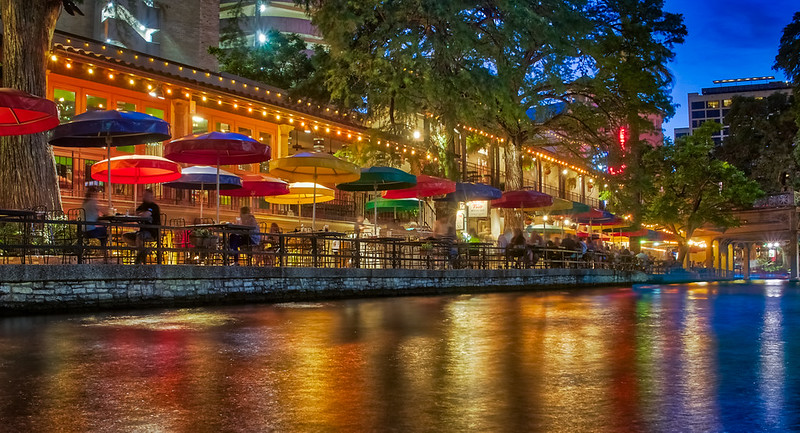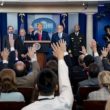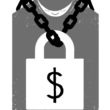SAN ANTONIO—Under a waning sun this week, a neighbor and I were quaffing takeout craft beers from an otherwise shuttered brew pub on the banks of the San Antonio River, contemplating the looming end of our city’s five weeks of plague-enforced hibernation.
Jim Wyatt, 73, is an asthmatic retired economics teacher, union organizer, and reserve Coast Guard captain. Though a bit younger, I’m asthmatic as well, with a history of even mild colds becoming serious chest infections.
Neither of us figures himself certain to survive a tangle with the coronavirus. Neither of us relishes having to try.
As I eyed a dozen laughing 20-somethings huddled with beers and without masks at an outdoor table a hundred yards away, Jim said he was “moderately scared, but not terrified,” of the consequences of the lockdown ending.
“I have to get out,” he said, sitting a few yards from me on shaded limestone blocks perched on the riverbank. Joggers, cyclists, dog walkers, and stroller pushers streamed past, most of them also sans-masks.
“I can’t stay trapped at home all day.”
Although testing for the virus still falls woefully short in Texas and though rates of infection continue to rise, Texas Gov. Greg Abbott ordered the state to begin a staggered reopening beginning today, May 1. Texas becomes the largest of a handful of states moving to reopen as political and economic considerations prevail over scientists’ warnings.
“Now it’s time to set a new course . . . that responsibly opens up business in Texas,” Abbott said recently in announcing his reopening plans, which have drawn praise from President Trump and business leaders.
Jim and I, and some 30 million other Texans, are being thrown into the breach.
Under Abbott’s plan, retail stores, malls, restaurants, and movie theaters open their doors first, but only up to a quarter of their normal customer capacity. If by mid-May data shows no increase in the virus’ spread, capacity can climb to half of normal. And even more contagion-risky venues like bars, gyms, barber shops, and beauty salons will then be allowed to open.
Abbott’s orders override the much more meticulous rules of many cities and towns, which include the mandatory wearing of face masks by anyone entering a store or otherwise coming in close contact with anyone else.
“It’s hard to get rid of this virus because it is so contagious,” Abbott said. “So, we’re not just going to open up and hope for the best.”
The arguments for re-opening are clear enough.
Texas, with a population 1.5 times that of the New York City metro area, has had just shy of 800 known virus-related deaths so far. The tri-state New York City area has seen more than 33,000 people succumb.
At the same time, the pandemic shutdown—combined with the collapse of petroleum prices exacerbated by demand being sapped by the lockdown—has sucked at least 1.5 million jobs from the state since mid-March. Houston alone looks to lose some 300,000 energy jobs as the oil industry collapses.
Nationwide, at least 30 million people have lost their jobs in less than two months.
But the relatively low death toll in Texas owes much to the state’s aggressive lockdown in March. Many fear that easing restrictions now will prove disastrous.
Movie theater chains, restaurants and shop owners say they fear unleashing a renewed outbreak among customers and employees alike. Many express doubt that working at a quarter of capacity, even for a short while, will prove profitable enough to justify the risk.
The mayors and county executives in the state’s largest urban centers—all but Fort Worth, governed by Democrats—have condemned the governors’ strategy as moving too fast.
“We are not through with this virus and the virus is not through with us,” warns San Antonio Mayor Ron Nirenberg, who along with leaders of other big Texas urban centers has led the lockdown efforts.
Many, if not most, Texans agree.
A recent poll by the University of Texas at Austin and The Texas Tribune, a non-profit publication focused on politics and social issues, found that more than nine in 10 respondents see the virus as a crisis or very serious threat. More than half the survey’s respondents said they were very worried about infection in their communities.
Still, some two-thirds of those polled said they also are very or extremely worried about the state’s economy.
Views of the virus and responses to it were sharply defined by political leanings, with most Democratic voters favoring continuing the lockdown until conditions are optimal and most Republicans wanting the opening accelerated.
“There are more important things than living,” Lt. Gov. Dan Patrick, a conservative former talk radio host and failed business owner from Houston, told a Fox News interviewer. “And that’s saving this country for my children and my grandchildren and saving this country for all of us.”
Most Texans live in fast-growing towns and cities in the central and eastern stretches of the state—a wetter, greener triangle roughly bounded by San Antonio, Austin, Dallas-Ft Worth and Houston. Dallas County, at some 2,600 people per square mile is the state’s most crowded, has less than a twentieth the population density of Manhattan.
A fifth of Texas’ 252 counties claim fewer than five inhabitants per square mile. Presidio County, anchored by the town of Marfa that has become a mecca for artists, celebrities, and not a few New York City natives, has just two people per square mile.
Frustration with the lockdown has been enhanced by the state’s short, but glorious spring. Recent days have been sunny, windy, and—topping at 85 degrees Fahrenheit—reasonably brisk for late April and early May. A few weeks hence, that glory will be burned away by a brain-addling scorch that will last through October.
In my neighborhood—little more than a mile south of downtown’s Alamo memorial—the frenzied restaurant and bar tourist mecca of our city’s famed Riverwalk gives way to a leafy greenway. Herons, egrets, ducks, and hawks flock here, sharing the riverbank with anglers who pull bass from the shallow, usually clear, stream.
From where Jim and I were enjoying our beers, a paved bike and jogging trail runs 10 miles further south, connecting sprawling parks, small reservoirs, and four other 16th-century missions like the Alamo.
Always popular, this so-called “mission reach” of the Riverwalk has proved a godsend for many during the quarantine. So too have the other aquifer-fed rivers that run clear and cold through the limestone Hill Country to the west of San Antonio and Austin.
I joined scores of other people last week lining the banks of a deep, shaded stretch of the Medina River in the town of Bandera. Though most of us kept to ourselves as we fished, swam, or just enjoyed the day, teenagers clustered around a rope swing or climbed 30 feet into the cypress trees to plunge into the river.
State officials reopened state parks in late April, so people could enjoy the rivers and lakes many of them offer.
“As we navigate through these challenging times, it is essential that outdoor experiences and opportunities are available for Texas families,” Carter Smith, the head of the state’s Parks and Wildlife Department said.
That many Texans’ take on the virus cuts along political lines is hardly surprising.
After 40 years of voting Republican in presidential elections, Texas has been sliding back toward a decidedly purple—if not yet blue—hue.
Though Trump won the state four years ago by a comfortable 9-point margin, his victory badly trailed Mitt Romney’s 16-point advantage over Barack Obama in 2012. The UT-Texas Tribune poll puts the president just five points ahead of Joe Biden in November’s match up, with a 2.8 percent margin of error. Another survey, by a Democratic polling firm, puts Biden ahead by a point.
Trump opponents understandably see opportunity in this crisis. His most fervent backers do as well.
“Texas is leading the way against the tyrants,” Alex Jones, the conspiracy monger and right-wing internet mogul, shouted to several hundred people gathered on April 18 at the state capitol in Austin to demand an end to anti-virus lockdown.
A few protesters unfurled a banner rejecting any anti-corona vaccine as a Satanic plot. “Texas will not take the mark of the Beast,” it vowed, calling on God or a righteous public to “deliver up treasonous men,” including Anthony Fauci, Bill Gates, and Treasury Secretary Steve Mnuchin.
“Let us work!,” the protesters chanted. “God bless Trump.”
And God help Texas.
As a staff correspondent for the Houston Chronicle, The Wall Street Journal, and other newspapers, Dudley Althaus has spent his career reporting on politics and other issues in Texas, the U.S.-Mexico border, and across Latin America.






0 Comments